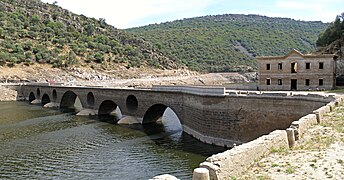Monfragüe
The article's lead section may need to be rewritten. (August 2016) |
| Monfragüe National Park | |
|---|---|
 A view of the Salto del Gitano | |
 Location of Monfragüe | |
| Location | Extremadura |
| Coordinates | 39°50′27″N 6°01′48″W / 39.84083°N 6.03000°W |
| Area | 179 km2 (69 sq mi)[citation needed] |
| Established | 2007 |
| Visitors | 331,788 (in 2008) |

Monfragüe (
Location
Monfragüe is a
Monfragüe is famous for its
History
The area's and the Park's name comes from the Latin Monsfragorum, "monte fragoso" (Spanish) which means "lush mountain".[3]
Prehistoric period
The mountains of Monfragüe house a great number of caves with
Roman period
Remains of Roman roads, bridges, fountains and gravestones can be found, since the park is close to the Ruta de la Plata (Silver Route). A section of the route, which goes down to the bridge of the Cardinal from Villarreal, can be considered as a vestige of Roman road. As in almost all Spanish geography, valleys provide the layout for the road. Remains of watchtowers exist, in Cerro Gimio for example.[3]
9th–19th century
During the ninth century, the castle of Monfragüe was built with five towers and two perimeters of walls. What is visible today are remnants of multiple restorations after military orders conquered it for
In 1450, Juan de Carvajal ordered the Cardinal's Bridge to be built entirely from granite ashlars; it facilitated communications between Plasencia and Trujillo. Since the bridge was practically the only one crossing the Tagus in the Extremadura, it gave rise to pillage, turning the area into a "paradise" of bandits and robbers hidden in its steep and impenetrable mountain ranges.[3]
At the beginning of the eighteenth century, the
The
20th century
During the Spanish Civil War in the nineteenthirties, the Extremadura was taken over rapidly. Rather than the conflict itself, the worst aspects were the hunger and poverty which followed. The impenetrable mountains with their maquis shrubland of the region were important to the highlander groups commanded by famous guerrillas like "Quincoces",[4] "Chaquetalarga" (Joaquín Ventas Cintas) and "the French" (Pedro Díaz Monje),[5]
In 1966, construction of the dam at Torrejón el Rubio, and the Alcántara Dam in 1969 altered the landscape irreversibly, as it submerged the wild beauty of the Tagus riverbanks along with its ecological and ethnological wealth.[3]
In 1968, Jesus Garzón arrived in the area, enamored of the beauty of Monfragüe and dedicated himself to
In 1991, Monfragüe was declared as a Special Protection Area for birds,[1] During the following years, the conservationist mentality, the infrastructure in Villarreal and publication efforts about the riches of the Park were strengthened. Since 2003, it has been recognised by
At the end of 2016, the area also received recognition as a dark-sky preserve.[7]
Biodiversity
Habitas in the park include extensive dense
The non-indigenous species are being eradicated.[when?] Commercial forestry is prohibited in Spanish national parks.[citation needed]
Birds
In 1988 the
Monfrague is an outstanding site for
Other breeding birds for which the park is important are
Other wildlife
Iberian lynx survived for a long time before numbers decreased. They were reintroduced and have since been doing well. [9] Deer and wild boar live in the park.
Gallery
-
National Park of Monfragüe, in Extremadura. View from the Castle.
-
Griffon vultures (Gyps fulvus) in the rocks of Monfragüe.
-
Griffon vultures (Gyps fulvus) in the rocks of Monfragüe.
-
Bridge over the Tagus River as it passes through the national park.
-
Jara in bloom in Monfragüe.
-
Deer during the 2008 roar.
-
Bee feeding on nectar in the Monfragüe National Park.
-
The Tagus River as it passes through the park.
-
Evergreen oaks ( Quercus ilex ) in the dehesa de Monfragüe.
-
El Salto del Gitano and the lookout for birds.
-
Puente del Cardenal, Monfragüe. It is only visible when the level of the Tagus River is very low.
References
- ^ a b (in Spanish) Spanish Ministry of the Environment website Archived 7 January 2010 at the Wayback Machine.
- ^ Monfragüe National Park TURESPAÑA, August 2016
- ^ a b c d e f g h i j Monfragüe: Historia Ministerio de Agricultura y Pesca, Alimentación y Medio Ambiente, not dated, retrieved 29 May 2017.
- ^ Quinoces El Hombre De Las Tierras Altas, 12 March 2011, retrieved 29 May 2017
- ^ Maquis En Extremadura El hombre de las tierras altas, 11 September 2009, retrieved 29 May 2017
- ^ Biosphere Reserve Directory, UNESCO
- ^ Monfragüe distinguido como Destino Starlight de Extremadura PlanVex, December 2016
- ^ BirdLife International (2012) Important Bird Areas factsheet: Monfragüe. Downloaded from http://www.birdlife.org on 17 June 2012
- ^ a b Monfragüe National Park www.spain.info Turespaña, 2018
External links
- Official site
- Official site Ambiente, Gobierno de Extremadura
- Magazine about Monfragüe Reddeparquesnacionales.com
- Website about Monfrague National Park











